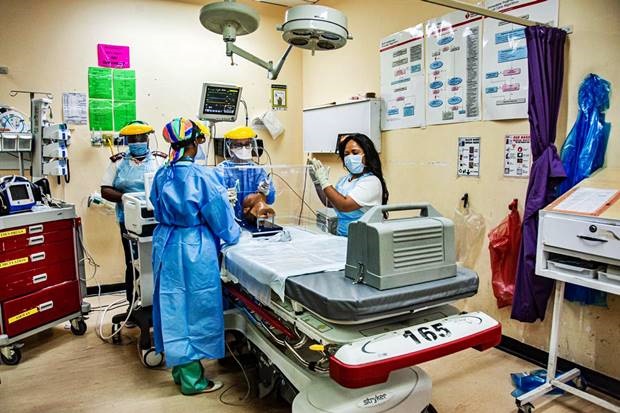DIY ventilation solutions and ‘self-sanitising’ masks - around the world, engineers and healthcare workers are coming up with creative answers to shortages of medical equipment in the fight against Covid-19.
In March, workers in the Western Cape, Mpumalanga and the North West told Bhekisisa about shortages of medical masks. The Western Cape and Mpumalanga health departments denied the allegations. Accusations such as these led the National Education, Health and Allied Workers Union (Nehawu) to take the government to court over the claims. The case was eventually dismissed.
But globally, shortages of not only protective gear such as masks but also ventilators have been a concern since before the coronavirus outbreak hit South Africa.
The new coronavirus, SARS-Cov-2, gives rise to Covid-19 disease. Because Covid-19 can attack the lungs, about a third of patients may need help breathing, according to two small studies published earlier this year in the Annals of Emergency Medicine and The Lancet medical journals. Up to one in 10, the research suggests, may need oxygen to be delivered via ventilators through tubes in the nose and mouth.
South Africa is now trying to increase the number of ventilators it has to prepare for a likely wave of coronavirus cases. Medical equipment — for instance, ventilators, medicines and even masks — has to be approved by the South African Health Products Regulatory Authority (SAHPRA) before they can be used in the country.
But here and abroad, healthcare workers and scientists are coming up with clever new solutions to fill the gaps in medical supplies and help better protect healthcare workers during the pandemic.
1. Microwave-sized wooden boxes could help patients breathe easier for thousands less than more expensive options
When patients are struggling to breathe, healthcare workers may place specialised masks attached to squeezable bags over their noses and mouths. As nurses or doctors manually compress the bags, air is pushed into the patient’s lungs.
The catch? Although these mask-bag combos are widely available globally, they require a healthcare worker to continuously pump the bag. This means healthcare workers may spend hours at a patient’s bedside.
Now, Rice University engineers in the United States have built microwave-sized machines that can pump the bags mechanically and precisely — without the help of healthcare workers.
“You get essentially all of the functionality of a full ventilator — with sensors and safeguards,” explains assistant professor of emergency medicine Rohith Malya in a YouTube video. Malya teaches at the Baylor College of Medicine, which partners with Rice University.
The open-source technology can be made for as little as R6 500, according to Rice University engineers. The devices may be able to replace more expensive machines for patients with less severe symptoms, engineers say.
2. US doctors found a way to re-use scarce respirator masks safely
Respirator masks — sometimes called N95 masks — are worn exclusively by healthcare workers. The specialised, disposable masks filter out tiny, potentially infectious particles from the air. Healthcare workers moving in and out of Covid-19 wards or transporting patients may go through several changes of these masks in a single shift, Anthony Reed, senior lecturer at the University of Cape Town’s department of anaesthesia and perioperative medicine told Bhekisisa in March. Reed is also part of SASA’s Covid-19 task team.
But the masks are in short supply all over the world.
So Researchers at the University of Nebraska Medical Center in the United States are using ultraviolet light to try to disinfect N95 masks and allow for repeat use, scientists describe in a recent report.
A 2018 study published in the American Journal of Infection Control showed that this kind of light significantly reduced the amount of H1N1 germs on masks. H1N1 is the virus that causes what’s been called swine flu.
The hospital says it’s been able to achieve even bigger reductions in bacteria and viruses on masks by stringing up N95 masks on clotheslines strung between two large towers of ultraviolet light. But researchers caution, the system only works as long as the masks hold their shape, or fit.
3. Joburg doctors teamed up to box up better protection for healthcare workers
SARS-CoV-2 is mostly spread through droplets generated when an infected person sneezes or coughs.
Patients are more likely to cough during procedures such as removing or inserting tubes from their throat — procedures that might be needed for those with serious Covid-19 disease.
A team at the Charlotte Maxeke Johannesburg Academic Hospital created something called an Intubox. The clear container is placed over a patient’s face and acts as a barrier between them — and any infectious droplets they might cough up — and healthcare workers.
Similar boxes are manufactured in the United States out of clear acrylic. There’s little publicly available research on how well these boxes work. But recently, doctors in the US simulated how far and wide patients’ salvia might be able to travel with and without the box.
In an article in the New England Journal of Medicine, researchers report that in the absence of an Intubox, droplets were found up to a metre away from the simulated patient — on the floor, on a nearby monitor and on the doctor. In contrast, when the box was used, this spray was confined mainly to the box and the doctor’s gloved hands and forearms.
But researchers noted the box took some getting used to and that health workers would need to be trained before using it.
4. Could ‘self-sanitising’ masks become a reality?
Northwestern University Professor of Materials Science Jiaxing Huang in the United States is hoping to give surgical masks an extra punch.
His team is investigating whether antiviral chemicals could be built into the medical masks themselves and would kill viruses on contact.
Speaking to the university, Huang said he hoped the solution would be able to fit any existing surgical mask and put an extra layer of protection between people who are infected with the virus and healthcare workers.
This story was produced by the Bhekisisa Centre for Health Journalism. Subscribe to the newsletter.




 Publications
Publications
 Partners
Partners














